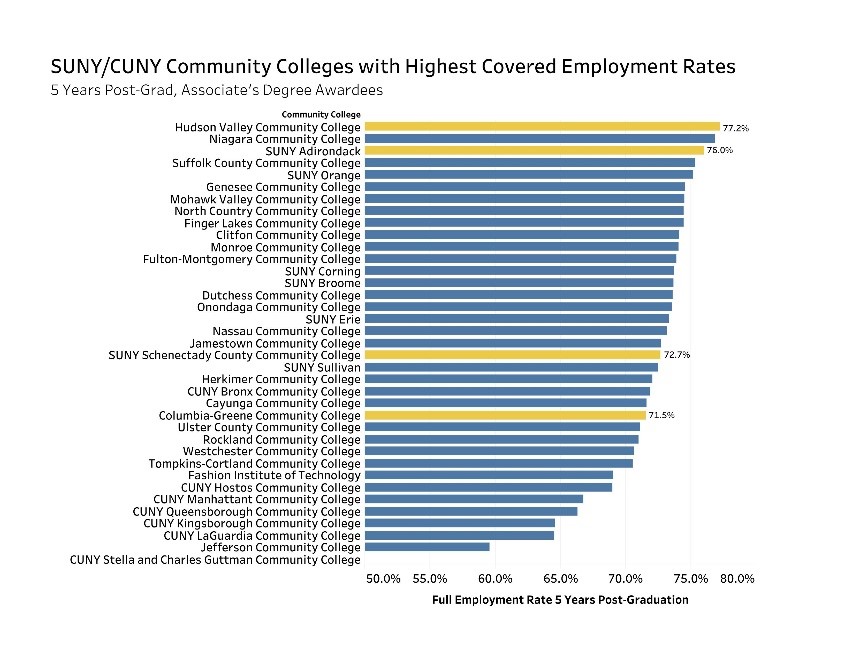4 in 5 Employed Capital Region SUNY Undergrads Are Still NYers 5 Years Post-Grad
HVCC has highest 5-year, post-grad employment rate among NYS community colleges, SUNY ADK has 3rd
About four in five Capital Region SUNY school graduates who were employed five years after receiving an associate’s or bachelor’s degree were still living in New York, according to a Center for Economic Growth (CEG) analysis of new data from the U.S. Census Bureau’s Post-Secondary Employment Outcomes (PSEO) Explorer.
The new PSEO data reveals how, out of the 21,986 graduates who received associate’s degrees from the region’s four SUNY community colleges between 2001 and 2010, 16,730 were employed five years post-graduation, resulting in a 76.1 percent covered employment rate1. Among those employed graduates, 85.3 percent were living in New York. New York’s retention rate for employed Hudson Valley Community College graduates five years post-graduation was 86.5 percent – the fifth highest rate among SUNY community colleges.
“SUNY graduates are such a valuable resource to our workforce, economy, and in our local communities. CEG is pleased to partner with SUNY institutions to help align their curriculum to ensure it meets the needs of area employers. Our labor force is getting a strong return on investment from our SUNY schools,” said CEG Chief Economic Development Officer Katie Newcombe.
“Skills-based workforce training and career preparation have been at the forefront of the college’s educational philosophy since we opened our doors nearly 70 years ago. Programs in healthcare, skilled trades, information technology, criminal justice, engineering, education, business and many more provide graduates with the skills to enter lucrative careers while supplying essential industries with the workers they need to drive economic development. Expert faculty and strong industry partnerships help create a clear path for our graduates from the classroom to the workplace. We are proud to prepare our graduates for the careers that enrich both their own lives and our shared economy, and the fact that so many Hudson Valley alumni choose to live and work here in our region is a testament to the positive impact that the college and its graduates have on the communities we serve,” said HVCC President Dr. Roger A. Ramsammy.
The Capital Region’s SUNY community colleges are SUNY Adirondack, HVCC, SUNY Schenectady and Columbia-Greene Community College (CGCC). PSEO does not count graduates as employed if they earn less than the annual equivalent of full-time work at the prevailing federal minimum wage and/or they have two or more quarters with no earnings in the reference year.2

Between 2001 and 2012, there were 29,513 UAlbany graduates who received bachelor’s degrees, and 77.8 percent of them were fully employed five years after graduating. Among those 22,973 employed undergraduates, 78.4 percent were living in New York.

Among the region’s employed community college graduates with an associate’s degree who left New York within five years post-graduation, the most popular U.S. regional divisions to which they migrated were South Atlantic (5 percent), other Middle Atlantic (2.1 percent) and New England (1.9 percent) states. Those regions were also the leading attractors of UAlbany undergraduates, attracting 6.5 percent, 4.1 percent and 3.3 percent, respectively. The least popular destination among Capital Region SUNY undergrads was the East South Central division, which includes Kentucky, Tennessee, Mississippi and Alabama.
Post-Graduation Employment
At 77.2 percent, HVCC had the highest five-year, post-graduation undergraduate covered employment rate among SUNY and CUNY community colleges.3 It was followed by Niagara County Community College (76.8 percent) and SUNY ADK (76 percent). The University at Albany’s five-year, post-graduation covered employment rate for bachelor’s degree awardees was 78 percent, which was the average for all SUNY and CUNY four-year colleges and universities.
CEG Activities
CEG has been working to help Capital Region workers enter and advance in careers in manufacturing and software development by partnering with local community colleges for programs such as HVCC’s Manufacturing Technology Pathways Project, SUNY Schenectady’s Certified Production Technician (CPT) program, SEMI’s Industry Approved Apprenticeship Program (IAAP) for GLOBALFOUNDRIES at HVCC, and a software developer apprenticeship program through SUNY Schenectady and Albany Can Code.
To help the Capital Region retain these skilled workers post-graduation, CEG and its affiliate, the Upstate Alliance for the Creative Economy (ACE), have been working on regional branding and the CapNY Talent Initiative. The initiative is designed to inform and attract and retain Millennial- and Gen-Z via a high-impact, multi-platform campaign incorporates social media, web, print, air and more. It aims to raise awareness nationally that the Capital Region is a leading place for young people to invest and thrive in their business, career and family lives.
Notes
1 Covered employment rate is the number of employed graduates over those with no or very low earnings.
2 Examples of non-covered employment are self-employment, military employment, or other similar situations (where unemployment insurance is not paid), according to the Census Bureau.
3 Five-year, post-graduation employment data was not available for Stella and Charles Guttman Community College, CUNY’s newest school that opened in 2012. It’s one-year, post-graduation employment rate was 94 percent.
Don’t miss these insights into the trends that are shaping the Capital Region’s economy. Sign up for CEG’s e-news and follow us on:














